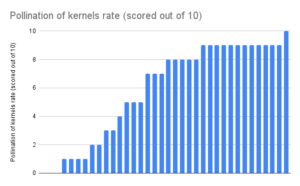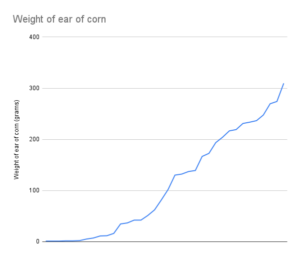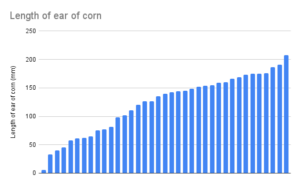Final report for FNC22-1337
Project Information
My farm is 0.46 acres in Evansville, IN, where I reside at my farmstead in an established urban core neighborhood. The house was built in 1962. There is a street light in the front yard that caused my light meter to measure 0.1W/m^2 at the edge of Circle #1 on a night with a new moon. It's bright enough to wake me up if gets in my eyes (cats push the shades up sometimes), so I am wondering if it interfered with the beans and squash. I am a creative entrepreneur, editor, artist, writer, and farmer. The crop circles were grass and clover lawn before this project. I also have pecan and mulberry trees, goumiberry bushes, a magnolia tree, an elderbush, and mints. I grew some tomatoes and eggplant last summer, which was my first time to grow them both. No livestock/dairy/grazing systems. I have 2 pet cats. I have been gardening for about 4 years at this location and I am now taking farming more seriously due to the potential for bettering my life situation (nutrition, fun, community, profit, biodiversity, educating) that I see due to doing this project. Before I received this grant, I wanted rainbarrels and through this project I have them now. The sustainable practices I did before receiving this grant money are as follows: interest in biodiversity (lifelong), planting hardy perennials (so I don't have to re-do everything annually), planting fruit and nut trees (lifelong interest in resilient food systems; planting as such as a child with father; been planting them for 4 years here).
Original Project Timeline for 2024 which was adjusted due to health challenges faced by the Principal Investigator, Lindsey Krantz:
January
- Submit project timeline for the 11-month no-cost extension with progress report
- Inquire about funding for printer assistance (start-up capital)
- Make outlines and assign ISBNs to the two books written for this project:
- String Revolution Method of Perennial Planting Layout
- Reflections and Research Findings from FNC22-1337
February
- Field research in Crop Circles #1, #2, and #3 to figure out how to explain the string revolution method
- Write out seven illustrative anecdotes from the project (qualitative data)
- Seeking funding assistance for printer
March
- Develop first half of outlines for both books into prose
- Seeking funding assistance for printer
April
- Develop second half of outlines for both books into prose
- Seeking funding assistance for printer
May
- Seeking funding assistance for printer
- Write introductions, indices, and glossaries for both books
- Space available to receive printer at farmstead
- Develop book distribution plan
June
- Printer funding assistance in place
- Specific printer identified to purchase (local preferred)
- Double check that there is space in laboratory to receive printer
- Formatting and editing of both books
- Continue development of outreach plan for book distribution
July
- Contract negotiations for printer
- Continue development of outreach plan for book distribution
August
- Contract for printer signed
- Printer delivered
- Acquire paper, ink, staples, etc. to print books
- Finalize outreach plan for book distribution
- Finalize formatting of books based on equipment capabilities
- Print books
September
- Print books
- Begin distributing books
October
- Continue distributing books through end of October
November
- Prepare and submit final report
December 2024
- Due date of final report for FNC22-1337:
- December 15, 2024
- Proposals for NCR-SARE's 2025-2026 Farmer Rancher Grant due
- TBA which day in December 2024
The timeline above has been preserved into this final project report to demonstrate how projects can be adjusted to conditions met in the field. Please see below for information from the end of the 11-month no-cost extension of time which I was grateful to receive to be able to complete this project. Thank you to all who made the no-cost (as in, no additional budget) extension of time possible.
Information from the proposal which still applies to the final outcomes of this project:
In this project, "Inspirational Three Sisters Mounds Sunshine Experiment with Sunflowers and Community Seed Distribution in Evansville, Indiana," we will grow three spectacular 24-ft-wide formations of seven 4-ft-wide mounds each. We will grow specialty/ancient varieties of corn, beans, squash, and sunflowers that are native to the Americas.
This project is ecologically sound, because 3 Sisters (corn, beans, and squash) enrich the soil and help each other grow. A 4th Sister of sunflowers enriches the fabric of the plantings, too, and will be planted on the North side of the formations to avoid shading the 3 Sisters.
This project is socially responsible, because it is a type of intercropping/symbiotic planting practiced in Indiana since time immemorial, but has died out almost completely in Evansville, IN. Much respect goes to Indigenous peoples' planting techniques which inspire this project. The community seed distribution will cause 3 Sisters plus sunflowers plantings to proliferate across Evansville, IN.
This project is economically viable, because it transforms lawns into productive cultivated land that can be cultivated for food production after this project. It pays decent compensation to the people working on the project.
Final notes about the outcomes from this project:
-
Respect and educate about the Indigenous agricultural practice of 3 Sisters (corn, squash, and beans) plus sunflowers mounds plantings.
-
-
Results: objective #1 successfully achieved.
-
I communicated in the languages of Spanish and English during project activities.
-
I spent most of my time at my vendor mall booth working on objective #1. For instance, my presentation to booth visitors started with the demonstration table. There were many questions about why exactly the Jimmy Red corn is red.
-
Neighbors and I discussed the project and about how productive agriculture enhances Evansville, Indiana, for the purposes of human nutrition, preservation of biodiversity in plant genetics, business/community/household development, pollinator habitat, and human flourishing. Discussions included topics about the water cycle, potassium cycle, phosphorus cycle, nitrogen cycle, and carbon cycle.
-
I spent extra effort on explaining the benefits and drawbacks to using cover crops as distributed by this project (medium-tall red clover and low-growing sweet clover).
-
When I discussed anything about the two small books I had planned for this project, not a single visitor expressed interest in reading the books themselves, but did their best to encourage me with variations of, “Oh, that sounds like an amazing idea. I wouldn't read it, but I'm sure someone else would read it with interest.” Due to such an obvious vote of no-confidence about creating such materials, I aborted the mission to create the two small books as not to waste federal funds and my precious time on a vainglorious endeavor.
-
-
Inspire an increase in urban agriculture by placing a spectacular 24ft diameter circular planting in my front yard and two 24ft plantings in by back yard (seven 4ft diameter by 4in raised mounds per planting), with 5 field days.
-
-
Results: objective #2 successfully achieved.
-
The circular planting in my front yard (Circle #1) attracted attention from my neighbors such that ears of corn went missing steadily over the growing season in 2023. See graph: “The Statistical Mystery of the Missing Jimmy Red Corn.”
-
Learning is a slow process. Many children walking to the schools close to my home (Dexter Elementary School and McGary Middle School in the Vanderburgh County School Corporation; Christ the King Roman Catholic School) have now seen that it is possible to grow corn, beans, squash, red clover, sweet clover, and sunflowers in an urban area. Now this project has encouraged many of my neighbor kids to know for themselves that caring for plants in a harsh urban environment is possible, beautiful, and worthwhile.
-
An avenue for future research is for scholars to study and implement plans for youth-directed agricultural inquiry (for example, increasing distribution of plant starts and utilization of 4-H resources in Evansville, Indiana).
-
-
Find out whether the shady or sunny plantings make more pounds of produce and distribute the information.
-
-
Results: objective #3 successfully achieved.
-
Circle #1 (nearly full sunshine) was much more productive than Circle #2 and Circle #3 in regards to the corn, beans, squash, and sunflowers plantings.
-
Circle #2 and Circle #3 were much more productive than Circle #1 in regards to volunteer trees (red oak and mulberry).
-
See visual aids: graph: “Spacing of Volunteer Trees in Crop Circles: Oak and Mulberry Trees Volunteered to Grow”; graph: “High-Value Plants Rising from Crop Circles: Volunteer Oak, Volunteer Mulberry, and More”; chart in 3 sections: “Various conditions present in NCR-SARE #FNC22-1337”: sunlight conditions, success of growth of plants, cover crop notes, square footage of crop circles, and other notes on conditions.
-
I encourage scholars to build upon my work, because mulberry and oak trees are valuable and there was so little input from me to get them to grow so heartily. As my family says about plants that pop up without our input: “Nothing beats stronger than the heart of a volunteer,” as in, transplants are weak compared to naturally-arising plants, especially trees.
-
A technique to encourage volunteer plants is selective mowing, in which desirable plants are spared from being mowed and allowed to flourish, such as with the many mulberry and oak trees now flourishing due to the creation of unmowed crop circles which this project funded.
-
-
Equip neighbors in Evansville, IN, with sunflower, squash, corn, and bean seeds, to be used to recreate my plantings or to innovate alike.
-
-
Results: objective #4 successfully achieved.
-
Discussions with neighbors about their dislike of weeding plant beds and difficulties with infertile soil led to the purchase and distribution of red clover seeds and sweet clover seeds with project funds.
-
Many people were unwilling to take corn, beans, squash, and sunflower seeds due to anxiety about wasting the seeds: “But what would I do with them? No thanks.” Such neighbors often accepted a distribution of clover seeds, because they are relatively simple to plant and maintain.
-
If I said anything to neighbors about “free seeds,” neighbors took no interest in acquiring the seeds from this project. The word “free” is stigmatized deeply to the point that I encourage scholars to build upon my research about how the word “free” makes people think that there is a hidden agenda and/or defect in the seeds due to them being “free.”
-
As compared to using the word “free,” neighbors were much more likely to discuss urban agriculture and to accept seeds from me when I described the seed offerings as “a seed distribution from a federally-funded farm project.”
-
Seeds funded: Arikara sunflowers (Helianthus annuus), Titan sunflowers (Helianthus annuus), Gete Okosomin squash (Curcubita maxima), Jimmy Red corn (Zea mays) from several growers, 1500-Year-Old New Mexican Cave beans (Phaseolus vulgaris), Cherokee Trail of Tears beans (Phaseolus vulgaris), medium-tall red clover (Trifolium pratense), low-growing sweet clover (Melilotus officinalis), and inoculant (Sinorhizobium meliloti and Rhizobium leguminosarum biovar trifolii) for the clover seeds.
-
A special thank-you goes to Joan Benjamin for mentoring me as a SARE grantee. Thanks also go to all of the SARE staff who made this project possible with their mentoring and efforts, as well. I [Lindsey Krantz, President, Catalpa Tree Publishing, LLC] appreciate you all very much.
-
Respect and educate about the Indigenous agricultural practice of 3 Sisters (corn, squash, and beans) plus sunflowers mounds plantings.
-
-
Results: objective #1 successfully achieved.
-
I communicated in the languages of Spanish and English during project activities.
-
I spent most of my time at my vendor mall booth working on objective #1. For instance, my presentation to booth visitors started with the demonstration table. There were many questions about why exactly the Jimmy Red corn is red.
-
Neighbors and I discussed the project and about how productive agriculture enhances Evansville, Indiana, for the purposes of human nutrition, preservation of biodiversity in plant genetics, business/community/household development, pollinator habitat, and human flourishing. Discussions included topics about the water cycle, potassium cycle, phosphorus cycle, nitrogen cycle, and carbon cycle.
-
I spent extra effort on explaining the benefits and drawbacks to using cover crops as distributed by this project (medium-tall red clover and low-growing sweet clover).
-
When I discussed anything about the two small books I had planned for this project, not a single visitor expressed interest in reading the books themselves, but did their best to encourage me with variations of, “Oh, that sounds like an amazing idea. I wouldn't read it, but I'm sure someone else would read it with interest.” Due to such an obvious vote of no-confidence about creating such materials, I aborted the mission to create the two small books as not to waste federal funds and my precious time on a vainglorious endeavor.
-
-
Inspire an increase in urban agriculture by placing a spectacular 24ft diameter circular planting in my front yard and two 24ft plantings in by back yard (seven 4ft diameter by 4in raised mounds per planting), with 5 field days.
-
-
Results: objective #2 successfully achieved.
-
The circular planting in my front yard (Circle #1) attracted attention from my neighbors such that ears of corn went missing steadily over the growing season in 2023. See graph: “The Statistical Mystery of the Missing Jimmy Red Corn.”
-
Learning is a slow process. Many children walking to the schools close to my home (Dexter Elementary School and McGary Middle School in the Vanderburgh County School Corporation; Christ the King Roman Catholic School) have now seen that it is possible to grow corn, beans, squash, red clover, sweet clover, and sunflowers in an urban area. Now this project has encouraged many of my neighbor kids to know for themselves that caring for plants in a harsh urban environment is possible, beautiful, and worthwhile.
-
An avenue for future research is for scholars to study and implement plans for youth-directed agricultural inquiry (for example, increasing distribution of plant starts and utilization of 4-H resources in Evansville, Indiana).
-
-
Find out whether the shady or sunny plantings make more pounds of produce and distribute the information.
-
-
Results: objective #3 successfully achieved.
-
Circle #1 (nearly full sunshine) was much more productive than Circle #2 and Circle #3 in regards to the corn, beans, squash, and sunflowers plantings.
-
Circle #2 and Circle #3 were much more productive than Circle #1 in regards to volunteer trees (red oak and mulberry).
-
See visual aids: graph: “Spacing of Volunteer Trees in Crop Circles: Oak and Mulberry Trees Volunteered to Grow”; graph: “High-Value Plants Rising from Crop Circles: Volunteer Oak, Volunteer Mulberry, and More”; chart in 3 sections: “Various conditions present in NCR-SARE #FNC22-1337”: sunlight conditions, success of growth of plants, cover crop notes, square footage of crop circles, and other notes on conditions.
-
I encourage scholars to build upon my work, because mulberry and oak trees are valuable and there was so little input from me to get them to grow so heartily. As my family says about plants that pop up without our input: “Nothing beats stronger than the heart of a volunteer,” as in, transplants are weak compared to naturally-arising plants, especially trees.
-
A technique to encourage volunteer plants is selective mowing, in which desirable plants are spared from being mowed and allowed to flourish, such as with the many mulberry and oak trees now flourishing due to the creation of unmowed crop circles which this project funded.
-
-
Equip neighbors in Evansville, IN, with sunflower, squash, corn, and bean seeds, to be used to recreate my plantings or to innovate alike.
-
-
Results: objective #4 successfully achieved.
-
Discussions with neighbors about their dislike of weeding plant beds and difficulties with infertile soil led to the purchase and distribution of red clover seeds and sweet clover seeds with project funds.
-
Many people were unwilling to take corn, beans, squash, and sunflower seeds due to anxiety about wasting the seeds: “But what would I do with them? No thanks.” Such neighbors often accepted a distribution of clover seeds, because they are relatively simple to plant and maintain.
-
If I said anything to neighbors about “free seeds,” neighbors took no interest in acquiring the seeds from this project. The word “free” is stigmatized deeply to the point that I encourage scholars to build upon my research about how the word “free” makes people think that there is a hidden agenda and/or defect in the seeds due to them being “free.”
-
As compared to using the word “free,” neighbors were much more likely to discuss urban agriculture and to accept seeds from me when I described the seed offerings as “a seed distribution from a federally-funded farm project.”
-
Seeds funded: Arikara sunflowers (Helianthus annuus), Titan sunflowers (Helianthus annuus), Gete Okosomin squash (Curcubita maxima), Jimmy Red corn (Zea mays) from several growers, 1500-Year-Old New Mexican Cave beans (Phaseolus vulgaris), Cherokee Trail of Tears beans (Phaseolus vulgaris), medium-tall red clover (Trifolium pratense), low-growing sweet clover (Melilotus officinalis), and inoculant (Sinorhizobium meliloti and Rhizobium leguminosarum biovar trifolii) for the clover seeds.
-
A special thank-you goes to Joan Benjamin for mentoring me as a SARE grantee. Thanks also go to all of the SARE staff who made this project possible with their mentoring and efforts, as well. I [Lindsey Krantz, President, Catalpa Tree Publishing, LLC] appreciate you all very much.
Research
The following section is preserved to demonstrate how project are adjusted to conditions when in contact with reality (visitors to my vendor booth showed zero interest in reading the proposed books, so I did not write them).
This will be brief and I will go into it at length in the book about the project that I'm going to write.
Three Sisters (corn, beans, squash) plus sunflowers are nutritious to humans and grow symbiotically. The display garden in the front yard (Circle #1) served as a way to inspire and familiarize the neighbors with these plants and the idea of growing food in their lawns instead of grass. Food is getting more expensive and biodiversity is going down, so this project aims to inspire people to take the plunge into farming. Judging from how my neighbors disappeared about half of the ears of corn, there is interest, at least in eating Jimmy Red Corn.
Managing people was very stressful. Given health constraints, for 2023, I am not going to be doing a display garden for this project. I am going to do something in the circles. The idea of doing basic science with it is not tenable because so much of the corn is going missing.
Seed distribution efforts and working with subcontractors was stressful, so that is one reason I am only going to distribute red clover seeds (to be planted where the farmer wants to turn grassy lawn into cultivated land soon). There was very little interest in signing up for seeds, as underlined by the very little interest in the free seed signup survey that I made. Due to this low interest and the crop failures with squash and beans in all of the Circles, it would be irresponsible to push the same seeds into the Evansville, IN, area, because I don't want people to try to farm but be discouraged by a crop failure.
I took several data points off of each ear of corn using a survey (data entry tool) that I designed:
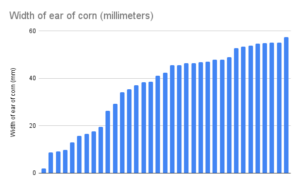
But these are probably only the smallest ears, considering that people picking, probably took the largest ears.
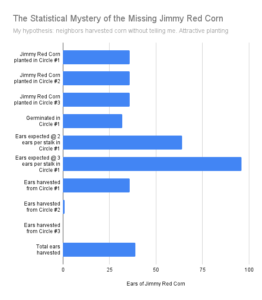
For this project, I developed a twine-based measurement system for building the crop circles. I was successful with it (all 3 circles were built to the correct dimensions). I have named it “the Krantz revolution method,” because it involves measurement of where to place soil and mulch by revolving the endpoint of a piece of twine around a stake in the middle of each of the mounds. The Krantz revolution method relies on geometric facts:
(1) all points on a circle are equidistant to that circle's center;
(2) a line segment that goes between a circle and its center is the radius;
(3) the radius of a circle is half as wide as the widest part (diameter) of a circle;
(4) when a circle is inscribed in a square;
(5) the circle and square have the same center and;
(6) the diameter of the circle equals the length of a side of the square.
Krantz revolution method steps, as developed in the project NCR SARE FNC22-1337:
Materials:
1. Twine (can be thin or thick but NOT stretchy), a twine-cutting tool such as scissors, a measuring tape, stakes, and EITHER a geomagnetic compass with degree measurements (preferred) AND/OR a protractor (functional but more difficult to use).
2. A schematic of the site can be helpful, but is not necessary to the Krantz revolution method.
3. Locate the center of each circle to be measured.
3.1. Depending on the individual project, this step will vary.
3.2. In this project, the three crop circles were each identically laid out.
3.3. Use a protractor or geomagnetic compass to find the centers of the circles. This part of the method will be extensively built out in the book.
4. Place a stake in the center of each circle.
5. Tie a piece of twine to each stake THEN cut the twine to the length of the radius of the circle to be measured.
6. PLEASE NOTE: After much trial and error, it was discovered that tying the twine to the stake and only then cutting it to size is more accurate, less time-consuming, and wastes less material on mistakes than cutting before tying.
7. Pull the twine tight between the stake and the end of the twine.
8. Revolve the twine around the stake at ground level.
9. The full area underneath the twine as it revolves is where the circle lays.
10. Place material, such as soil or mulch, either underneath the twine (within the circle) or not underneath the twine (outside of the circle).
The development of the Krantz revolution method was inspired by reading about how ancient Egyptians used knotted rope to create a right triangle with sides the lengths of 3, 4, and 5 units for reference. For example, for squaring corners of buildings. The 3-4-5 right triangle is also the basis of the Pythagorean theorem.
Update at the end of the project for its final report:
See "Results and Discussion" section in this report.
Project objectives from proposal:
-
Respect and educate about the Indigenous agricultural practice of 3 Sisters (corn, squash, and beans) plus sunflowers mounds plantings.
-
-
Results: objective #1 successfully achieved.
-
I communicated in the languages of Spanish and English during project activities.
-
I spent most of my time at my vendor mall booth working on objective #1. For instance, my presentation to booth visitors started with the demonstration table. There were many questions about why exactly the Jimmy Red corn is red.
-
Neighbors and I discussed the project and about how productive agriculture enhances Evansville, Indiana, for the purposes of human nutrition, preservation of biodiversity in plant genetics, business/community/household development, pollinator habitat, and human flourishing. Discussions included topics about the water cycle, potassium cycle, phosphorus cycle, nitrogen cycle, and carbon cycle.
-
I spent extra effort on explaining the benefits and drawbacks to using cover crops as distributed by this project (medium-tall red clover and low-growing sweet clover).
-
When I discussed anything about the two small books I had planned for this project, not a single visitor expressed interest in reading the books themselves, but did their best to encourage me with variations of, “Oh, that sounds like an amazing idea. I wouldn't read it, but I'm sure someone else would read it with interest.” Due to such an obvious vote of no-confidence about creating such materials, I aborted the mission to create the two small books as not to waste federal funds and my precious time on a vainglorious endeavor.
-
-
Inspire an increase in urban agriculture by placing a spectacular 24ft diameter circular planting in my front yard and two 24ft plantings in by back yard (seven 4ft diameter by 4in raised mounds per planting), with 5 field days.
-
-
Results: objective #2 successfully achieved.
-
The circular planting in my front yard (Circle #1) attracted attention from my neighbors such that ears of corn went missing steadily over the growing season in 2023. See graph: “The Statistical Mystery of the Missing Jimmy Red Corn.”
-
Learning is a slow process. Many children walking to the schools close to my home (Dexter Elementary School and McGary Middle School in the Vanderburgh County School Corporation; Christ the King Roman Catholic School) have now seen that it is possible to grow corn, beans, squash, red clover, sweet clover, and sunflowers in an urban area. Now this project has encouraged many of my neighbor kids to know for themselves that caring for plants in a harsh urban environment is possible, beautiful, and worthwhile.
-
An avenue for future research is for scholars to study and implement plans for youth-directed agricultural inquiry (for example, increasing distribution of plant starts and utilization of 4-H resources in Evansville, Indiana).
-
-
Find out whether the shady or sunny plantings make more pounds of produce and distribute the information.
-
-
Results: objective #3 successfully achieved.
-
Circle #1 (nearly full sunshine) was much more productive than Circle #2 and Circle #3 in regards to the corn, beans, squash, and sunflowers plantings.
-
Circle #2 and Circle #3 were much more productive than Circle #1 in regards to volunteer trees (red oak and mulberry).
-
See visual aids: graph: “Spacing of Volunteer Trees in Crop Circles: Oak and Mulberry Trees Volunteered to Grow”; graph: “High-Value Plants Rising from Crop Circles: Volunteer Oak, Volunteer Mulberry, and More”; chart in 3 sections: “Various conditions present in NCR-SARE #FNC22-1337”: sunlight conditions, success of growth of plants, cover crop notes, square footage of crop circles, and other notes on conditions.
-
I encourage scholars to build upon my work, because mulberry and oak trees are valuable and there was so little input from me to get them to grow so heartily. As my family says about plants that pop up without our input: “Nothing beats stronger than the heart of a volunteer,” as in, transplants are weak compared to naturally-arising plants, especially trees.
-
A technique to encourage volunteer plants is selective mowing, in which desirable plants are spared from being mowed and allowed to flourish, such as with the many mulberry and oak trees now flourishing due to the creation of unmowed crop circles which this project funded.
-
-
Equip neighbors in Evansville, IN, with sunflower, squash, corn, and bean seeds, to be used to recreate my plantings or to innovate alike.
-
-
Results: objective #4 successfully achieved.
-
Discussions with neighbors about their dislike of weeding plant beds and difficulties with infertile soil led to the purchase and distribution of red clover seeds and sweet clover seeds with project funds.
-
Many people were unwilling to take corn, beans, squash, and sunflower seeds due to anxiety about wasting the seeds: “But what would I do with them? No thanks.” Such neighbors often accepted a distribution of clover seeds, because they are relatively simple to plant and maintain.
-
If I said anything to neighbors about “free seeds,” neighbors took no interest in acquiring the seeds from this project. The word “free” is stigmatized deeply to the point that I encourage scholars to build upon my research about how the word “free” makes people think that there is a hidden agenda and/or defect in the seeds due to them being “free.”
-
As compared to using the word “free,” neighbors were much more likely to discuss urban agriculture and to accept seeds from me when I described the seed offerings as “a seed distribution from a federally-funded farm project.”
-
Seeds funded: Arikara sunflowers (Helianthus annuus), Titan sunflowers (Helianthus annuus), Gete Okosomin squash (Curcubita maxima), Jimmy Red corn (Zea mays) from several growers, 1500-Year-Old New Mexican Cave beans (Phaseolus vulgaris), Cherokee Trail of Tears beans (Phaseolus vulgaris), medium-tall red clover (Trifolium pratense), low-growing sweet clover (Melilotus officinalis), and inoculant (Sinorhizobium meliloti and Rhizobium leguminosarum biovar trifolii) for the clover seeds.
-
A special thank-you goes to Joan Benjamin for mentoring me as a SARE grantee. Thanks also go to all of the SARE staff who made this project possible with their mentoring and efforts, as well. I [Lindsey Krantz, President, Catalpa Tree Publishing, LLC] appreciate you all very much.
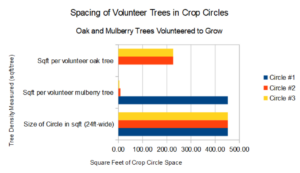
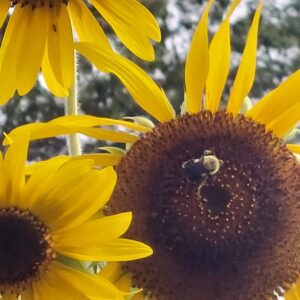
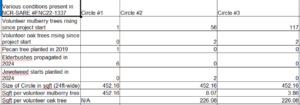
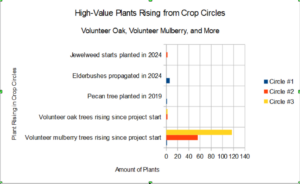










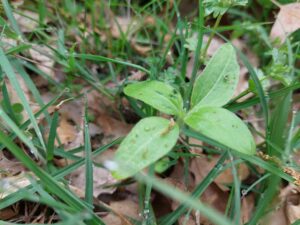








![Quote from Vincent van Gogh on wall at the Indianapolis Museum of Art, 2022: "THE SUNFLOWER IS MINE, IN A WAY. Adapted from Vincent's letter to Theo, Arles [France], January 1889." Sunflower sketch at right. Photography by Farmer Lindsey Krantz.](https://projects.sare.org/media/img/2/0/2/20220501_153507-300x135.jpg)
Educational & Outreach Activities
Participation Summary:
This outdated information about writing these two small is included here to demonstrate that projects can be adjusted:
In 2023 (Year 2), I plan to publish 2 books for this project: 1) a deep dive into what happened during Year 1 and 2) a method book for the Krantz revolution method of building circular plantings (developed from working on this project). The books will be published digitally, hardcover, and paperback. I think that books are better than field days and harvest celebrations at getting the information from this project out to the public and into the hands of farmers and of farmers-to-be who will be inspired by this simplified method of building circular crop formations. The interest in the project is "high intensity but low density interest": individuals who are interested are VERY interested but I don't come across them that often.
The display garden in my front yard (Circle #1) was designed to serve as a spectacularly attractive advertisement for Jimmy Red Corn, the other plants, and for urban agriculture in general, and I think that my neighbors who go by on foot REALLY liked the Jimmy Red Corn, because about half to 3/5 of it is missing from the field. See next figure: The Statistical Mystery of the Missing Jimmy Red Corn.
So even though attendance at Field Days was low (and the Harvest Festival was cancelled due to illness), obviously the front yard Circle #1 has served strongly to get the message out about urban agriculture with heirloom varieties and my neighbors liked what they ate. I think they took the squash blossoms from Circle #1, too. It wasn't the deer getting the corn, because the corn disappeared slowly and the deer ravaged the sunflowers all at once one night, as if they didn't normally go into the front yard (maybe due to the street light). Nothing was damaged, though I did lose a digital calipers and had to buy another one. Perhaps the corn loving people also took the calipers.
The 2 field days went well, in spite of low attendance. The 3 sisters stew that we cooked at the 2nd field day in a cast iron Dutch oven was delicious. Due to my disabilities, I cannot do more public events here at this time. I am going to reach out to people via the written word instead of expecting them to come to me.
I reached out to about 25 media and none of them wanted to cover the project.
Education/Outreach Materials:
- (Conference/Presentation Material)
- (Decision-making Tool)
- (Decision-making Tool, Mobile/Desktop Application, Workbook/Worksheet)
- (Conference/Presentation Material, Course or Curriculum, Decision-making Tool, Fact Sheet, Workbook/Worksheet)
- (Display)
- (Bulletin, Decision-making Tool, Display)
- (Decision-making Tool, Display)
- (Article/Newsletter/Blog, Conference/Presentation Material, Fact Sheet, Website)
- (Article/Newsletter/Blog, Conference/Presentation Material, Fact Sheet, Website)
- Mosaic of Circle #3 for social media (Article/Newsletter/Blog, Conference/Presentation Material, Fact Sheet, Website)
Learning Outcomes
Project objectives from proposal:
-
Respect and educate about the Indigenous agricultural practice of 3 Sisters (corn, squash, and beans) plus sunflowers mounds plantings.
-
-
Results: objective #1 successfully achieved.
-
I communicated in the languages of Spanish and English during project activities.
-
I spent most of my time at my vendor mall booth working on objective #1. My presentation to booth visitors started with the demonstration table. There were many questions about why exactly the Jimmy Red corn is red: I encourage scholars to investigate this matter to build upon my scholarship, as there is little scholarly literature about why “Indian corn” [the name by which many of my neighbors know heirloom corn] takes form in so many colors.
-
Neighbors and I discussed the project and about how productive agriculture enhances Evansville, Indiana, for the purposes of human nutrition, preservation of biodiversity in plant genetics, business/community/household development, pollinator habitat, and human flourishing. Discussions included topics about the water cycle, potassium cycle, phosphorus cycle, nitrogen cycle, and carbon cycle.
-
I spent extra effort on explaining the benefits and drawbacks to using cover crops as distributed by this project (medium-tall red clover and low-growing sweet clover).
-
When I discussed anything about the two small books I had planned for this project, not a single visitor expressed interest in reading the books themselves, but did their best to encourage me with variations of, “Oh, that sounds like an amazing idea. I wouldn't read it, but I'm sure someone else would read it with interest.” Due to such an obvious vote of no-confidence about creating such materials, I aborted the mission to create the two small books as not to waste federal funds and my precious time on a vainglorious endeavor.
-
-
Inspire an increase in urban agriculture by placing a spectacular 24ft diameter circular planting in my front yard and two 24ft plantings in by back yard (seven 4ft diameter by 4in raised mounds per planting), with 5 field days.
-
-
Results: objective #2 successfully achieved.
-
The circular planting in my front yard (Circle #1) attracted attention from my neighbors such that ears of corn went missing steadily over the growing season in 2023. See graph: “The Statistical Mystery of the Missing Jimmy Red Corn.”
-
Learning is a slow process. Many children walking to the schools close to my home (Dexter Elementary School and McGary Middle School in the Vanderburgh County School Corporation; Christ the King Roman Catholic School) have now seen that it is possible to grow corn, beans, squash, red clover, sweet clover, and sunflowers in an urban area. Now this project has encouraged many of my neighbor kids to know for themselves that caring for plants in a harsh urban environment is possible, beautiful, and worthwhile.
-
An avenue for future research is for scholars to study and implement plans for youth-directed agricultural inquiry (for example, increasing distribution of plant starts and utilization of 4-H resources in Evansville, Indiana).
-
-
Find out whether the shady or sunny plantings make more pounds of produce and distribute the information.
-
-
Results: objective #3 successfully achieved.
-
Circle #1 (nearly full sunshine) was much more productive than Circle #2 and Circle #3 in regards to the corn, beans, squash, and sunflowers plantings.
-
Circle #2 and Circle #3 were much more productive than Circle #1 in regards to volunteer trees (red oak and mulberry).
-
See visual aids: graph: “Spacing of Volunteer Trees in Crop Circles: Oak and Mulberry Trees Volunteered to Grow”; graph: “High-Value Plants Rising from Crop Circles: Volunteer Oak, Volunteer Mulberry, and More”; chart in 3 sections: “Various conditions present in NCR-SARE #FNC22-1337”: sunlight conditions, success of growth of plants, cover crop notes, square footage of crop circles, and other notes on conditions.
-
I encourage scholars to build upon my work, because mulberry and oak trees are valuable and there was so little input from me to get them to grow so heartily. As my family says about plants that pop up without our input: “Nothing beats stronger than the heart of a volunteer,” as in, transplants are weak compared to naturally-arising plants, especially trees.
-
A technique to encourage volunteer plants is selective mowing, in which desirable plants are spared from being mowed and allowed to flourish, such as with the many mulberry and oak trees now flourishing due to the creation of unmowed crop circles which this project funded.
-
-
Equip neighbors in Evansville, IN, with sunflower, squash, corn, and bean seeds, to be used to recreate my plantings or to innovate alike.
-
-
Results: objective #4 successfully achieved.
-
Discussions with neighbors about their dislike of weeding plant beds and difficulties with infertile soil led to the purchase and distribution of red clover seeds and sweet clover seeds with project funds.
-
Many people were unwilling to take corn, beans, squash, and sunflower seeds due to anxiety about wasting the seeds: “But what would I do with them? No thanks.” Such neighbors often accepted a distribution of clover seeds, because they are relatively simple to plant and maintain.
-
If I said anything to neighbors about “free seeds,” neighbors took no interest in acquiring the seeds from this project. The word “free” is stigmatized deeply to the point that I encourage scholars to build upon my research about how the word “free” makes people think that there is a hidden agenda and/or defect in the seeds due to them being “free.”
-
As compared to using the word “free,” neighbors were much more likely to discuss urban agriculture and to accept seeds from me when I described the seed offerings as “a seed distribution from a federally-funded farm project.”
-
Seeds funded: Arikara sunflowers (Helianthus annuus), Titan sunflowers (Helianthus annuus), Gete Okosomin squash (Curcubita maxima), Jimmy Red corn (Zea mays) from several growers, 1500-Year-Old New Mexican Cave beans (Phaseolus vulgaris), Cherokee Trail of Tears beans (Phaseolus vulgaris), medium-tall red clover (Trifolium pratense), low-growing sweet clover (Melilotus officinalis), and inoculant (Sinorhizobium meliloti and Rhizobium leguminosarum biovar trifolii) for the clover seeds.
-
A special thank-you goes to Joan Benjamin for mentoring me as a SARE grantee. Thanks also go to all of the SARE staff who made this project possible with their mentoring and efforts, as well. I [Lindsey Krantz, President, Catalpa Tree Publishing, LLC] appreciate you all very much.
Project Outcomes
Recommendations for future avenues for research are included in this section:
Project objectives from proposal:
-
Respect and educate about the Indigenous agricultural practice of 3 Sisters (corn, squash, and beans) plus sunflowers mounds plantings.
-
-
Results: objective #1 successfully achieved.
-
I communicated in the languages of Spanish and English during project activities.
-
I spent most of my time at my vendor mall booth working on objective #1. For instance, my presentation to booth visitors started with the demonstration table. There were many questions about why exactly the Jimmy Red corn is red.
-
Neighbors and I discussed the project and about how productive agriculture enhances Evansville, Indiana, for the purposes of human nutrition, preservation of biodiversity in plant genetics, business/community/household development, pollinator habitat, and human flourishing. Discussions included topics about the water cycle, potassium cycle, phosphorus cycle, nitrogen cycle, and carbon cycle.
-
I spent extra effort on explaining the benefits and drawbacks to using cover crops as distributed by this project (medium-tall red clover and low-growing sweet clover).
-
When I discussed anything about the two small books I had planned for this project, not a single visitor expressed interest in reading the books themselves, but did their best to encourage me with variations of, “Oh, that sounds like an amazing idea. I wouldn't read it, but I'm sure someone else would read it with interest.” Due to such an obvious vote of no-confidence about creating such materials, I aborted the mission to create the two small books as not to waste federal funds and my precious time on a vainglorious endeavor.
-
-
Inspire an increase in urban agriculture by placing a spectacular 24ft diameter circular planting in my front yard and two 24ft plantings in by back yard (seven 4ft diameter by 4in raised mounds per planting), with 5 field days.
-
-
Results: objective #2 successfully achieved.
-
The circular planting in my front yard (Circle #1) attracted attention from my neighbors such that ears of corn went missing steadily over the growing season in 2023. See graph: “The Statistical Mystery of the Missing Jimmy Red Corn.”
-
Learning is a slow process. Many children walking to the schools close to my home (Dexter Elementary School and McGary Middle School in the Vanderburgh County School Corporation; Christ the King Roman Catholic School) have now seen that it is possible to grow corn, beans, squash, red clover, sweet clover, and sunflowers in an urban area. Now this project has encouraged many of my neighbor kids to know for themselves that caring for plants in a harsh urban environment is possible, beautiful, and worthwhile.
-
An avenue for future research is for scholars to study and implement plans for youth-directed agricultural inquiry (for example, increasing distribution of plant starts and utilization of 4-H resources in Evansville, Indiana).
-
-
Find out whether the shady or sunny plantings make more pounds of produce and distribute the information.
-
-
Results: objective #3 successfully achieved.
-
Circle #1 (nearly full sunshine) was much more productive than Circle #2 and Circle #3 in regards to the corn, beans, squash, and sunflowers plantings.
-
Circle #2 and Circle #3 were much more productive than Circle #1 in regards to volunteer trees (red oak and mulberry).
-
See visual aids: graph: “Spacing of Volunteer Trees in Crop Circles: Oak and Mulberry Trees Volunteered to Grow”; graph: “High-Value Plants Rising from Crop Circles: Volunteer Oak, Volunteer Mulberry, and More”; chart in 3 sections: “Various conditions present in NCR-SARE #FNC22-1337”: sunlight conditions, success of growth of plants, cover crop notes, square footage of crop circles, and other notes on conditions.
-
I encourage scholars to build upon my work, because mulberry and oak trees are valuable and there was so little input from me to get them to grow so heartily. As my family says about plants that pop up without our input: “Nothing beats stronger than the heart of a volunteer,” as in, transplants are weak compared to naturally-arising plants, especially trees.
-
A technique to encourage volunteer plants is selective mowing, in which desirable plants are spared from being mowed and allowed to flourish, such as with the many mulberry and oak trees now flourishing due to the creation of unmowed crop circles which this project funded.
-
-
Equip neighbors in Evansville, IN, with sunflower, squash, corn, and bean seeds, to be used to recreate my plantings or to innovate alike.
-
-
Results: objective #4 successfully achieved.
-
Discussions with neighbors about their dislike of weeding plant beds and difficulties with infertile soil led to the purchase and distribution of red clover seeds and sweet clover seeds with project funds.
-
Many people were unwilling to take corn, beans, squash, and sunflower seeds due to anxiety about wasting the seeds: “But what would I do with them? No thanks.” Such neighbors often accepted a distribution of clover seeds, because they are relatively simple to plant and maintain.
-
If I said anything to neighbors about “free seeds,” neighbors took no interest in acquiring the seeds from this project. The word “free” is stigmatized deeply to the point that I encourage scholars to build upon my research about how the word “free” makes people think that there is a hidden agenda and/or defect in the seeds due to them being “free.”
-
As compared to using the word “free,” neighbors were much more likely to discuss urban agriculture and to accept seeds from me when I described the seed offerings as “a seed distribution from a federally-funded farm project.”
-
Seeds funded: Arikara sunflowers (Helianthus annuus), Titan sunflowers (Helianthus annuus), Gete Okosomin squash (Curcubita maxima), Jimmy Red corn (Zea mays) from several growers, 1500-Year-Old New Mexican Cave beans (Phaseolus vulgaris), Cherokee Trail of Tears beans (Phaseolus vulgaris), medium-tall red clover (Trifolium pratense), low-growing sweet clover (Melilotus officinalis), and inoculant (Sinorhizobium meliloti and Rhizobium leguminosarum biovar trifolii) for the clover seeds.
-
A special thank-you goes to Joan Benjamin for mentoring me as a SARE grantee. Thanks also go to all of the SARE staff who made this project possible with their mentoring and efforts, as well. I [Lindsey Krantz, President, Catalpa Tree Publishing, LLC] appreciate you all very much.
